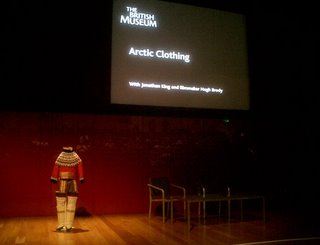 Inuit technology and resourcefulness are amazing. Darwinism in action.
Inuit technology and resourcefulness are amazing. Darwinism in action.The speakers highlighted the dangers of the arctic environment and how clothing, especially the boots, had to be perfect in all respects, otherwise the life of the wearer is at risk. Wet is one of the great dangers. Heat is seen as a fluid to be trapped round the body - yet the clothing must be loose so that excess heat can be released. Skin from caribou killed in the autumn, when the winter coat is growing in and is still short, is the best material and traditional clothes consist of one layer worn hair in, another worn hair outward. Even now a caribou layer is worn under modern clothes in cold weather.
The caribou parka that was on display comes from the handling collection. It was shedding a bit, but beautifully sewn. In fact the sewing skill is what gives these garments prestige value.
 Another type of prestige value comes from the materials used. The Greenland costume that sat on the stage was made in the 1930s for the daughter of the Danish high commissioner, and had a bead collar about three times as deep as even a high-status local would have. The central strips on the trousers are made up of tiny squares of coloured skin, and the high leggings are adorned with lace and flowers cross-stitched in pastel colours. People seized on new materials as they became available, brought in from Denmark (with its tradition of cross-stitch flower embroidery) in this case.
Another type of prestige value comes from the materials used. The Greenland costume that sat on the stage was made in the 1930s for the daughter of the Danish high commissioner, and had a bead collar about three times as deep as even a high-status local would have. The central strips on the trousers are made up of tiny squares of coloured skin, and the high leggings are adorned with lace and flowers cross-stitched in pastel colours. People seized on new materials as they became available, brought in from Denmark (with its tradition of cross-stitch flower embroidery) in this case. The programme included a film made in the late 1950s among the Netsilik Inuit, just filming with no commentary - or subtitles. Apparently the film was made without sound, then years later shown to the people who were in it, and they could remember what they had said, so that was recorded and dubbed.
The programme included a film made in the late 1950s among the Netsilik Inuit, just filming with no commentary - or subtitles. Apparently the film was made without sound, then years later shown to the people who were in it, and they could remember what they had said, so that was recorded and dubbed. This was at a time when Inuit (or Eskimos, in those pre-PC days) culture was on the cusp of being "modernised." Several families agreed to live in the traditional way for a year and allow filming - an early "1900s House." Apparently there was a lot of dispute about the editing and distribution, and eventually the National Film Board of Canada took it over.
The film showed the making of an igloo (deft cuts with snow knife) and a sledge (frozen caribou skin used to make the runners, with moss and ice to make it go smoothly, as well as cutting out a parka and mealtime. There are a dozen of these 20-30 minute films. Fascinating.
No comments:
Post a Comment